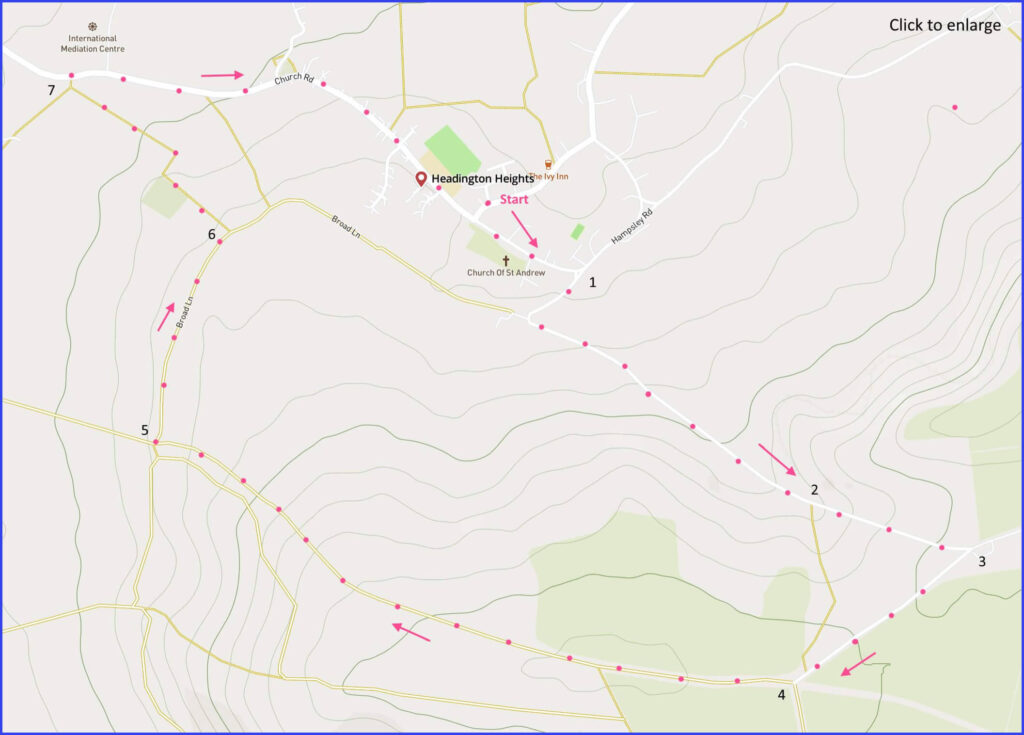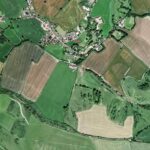A 4-mile walk starting from the ‘hidden’ village of Heddington in Wiltshire. The walk is entirely on paved roads, byways, or farm lanes. There are no stiles but some lane ascents and descents. Last part can be muddy underfoot if recent wet weather. A very rural walk across land that mixes arable and pasture. Click here for an ariel view. Click here for a PDF download/print
(Routes suggested from each map point + metres to next point)
Start: Exit the car park and return to walk left on Church road, past church until T-junction. 340m
1: Take the left route and follow a gently sloping road. 800m
2: Avoid temptation of left pointing footpath here (it’s not as mapped), instead carry forward to juntion. 390m
3: Turn right at junction, walk towards four way intersection. 440m
4: Take lane to right and walk towards downhill incline and, finally, 4-way path junction. 1.4km
5: Take restricted byway lane through wooded area to left path of Y-junction. 450m
6: Follow Z-shaped path towards Church Road.. 500m
7: Turn right on main road and follow it back to village start point. 1km
The pictures below are in the order things were seen on this walk. Clicking on any one will enlarge it (and the slideshow)
The walk
The village is ribboned along one street. Look for a sign to ‘car park’ – which is behind the primary school and village hall. The route here offers a good 4-mile walk for those who seek firm and continuous lanes underfoot – rather than a lot of gates, stiles and cattle to negotiate. Well, excepting the later part between points 5 and 6 where – if there has been recent rain – you can expect some build up of mud on the path.
Expect some steep incline walking up to point 3 on the map [D]. To your left on that lane is Kings Play Hill, a 230m summit that is a Site of Special Scientific Interest for its botanical richness. Also on that same hill is a Neolithic long barrow and a bowl barrow containing a Saxon burial.
The section from point 4 to 5 will afford good views across to Roundway Down [E] – site of a famous civil war battle. Royalists had a (short-lived) success there in 1643. After that point the route heads steeply downhill – be sure not to miss the right turn into a lane at point 5. The walk back to start is on a public road, but it’s wide enough, not too busy, and has verges along most of it. In general: expect good views on this walk and a lack of any traffic (or other walkers).
Heddington village
Heddington is one of 4 villages near Calne that are joined by a rectangle of roads. Apart from those other three villages, Heddington is not on the way to or from anywhere else. From the walker’s point of view this is a good thing: the village offers a starting point for a circular walk on which you will meet very little traffic – beyond the occasional horse rider.
The village itself is an unexceptional mix of housing stretching along the main street (Church Road). Nevertheless there are two buildings in Heddington definitely worth knowing about. The first is the 13th century St Andrew’s parish church [A]. The interior is strikingly bright (no stained glass and white walls) and the large churchyard around it is a pleasure to walk through. The 18th century Heddington manor house is directly opposite but it is skilfully concealed by a driveway and a large clump of trees.
The other building of special interest is Splatt’s House. This is also concealed – by a driveway with clear ‘private’ notices. However, privacy here does make sense. Because it is home to the International Meditation Centre. If you peak over the surrounding hedges at point 7 on the map, you may see a brightly gilded Burmese stupa [F]. Courses are available and the innocent walker may experience temptation of the “might give that a go” variety. Particularly as there is no fee (although a donation is suggested). However, be warned that a weekend course will involve shared accommodation, much silence, no books or gadgets, and a 4 am rise to start the meditational day.
Splatt’s House is of some historic interest. The land was purchased for building by Robert Child, a clothier. (There is no stream or river near Heddington, so its wool history was cottage-based weaving – undermined by subsequent mechanisation). Robert Child had a son, Francis Child. In later life Francis went on to be Mayor of London, an MP for Devizes (first Whig then Tory), and jeweller to the king. But his greatest achievement was founding one of the first English banks – Child & Co. He became so personally wealthy that he even leant money to the Crown.
Finally, at the end of your walk perhaps consider dropping into the Ivy Inn. Not only will it serve you a drink, it has also taken over some of the ‘only shop in the village’ role. This is a very quiet place.



![[A]](https://wiltshirewalks.com/wp-content/uploads/2022/11/headington_01-150x150.jpeg)
![[B]](https://wiltshirewalks.com/wp-content/uploads/2022/11/headington_02-150x150.jpeg)
![[C]](https://wiltshirewalks.com/wp-content/uploads/2022/11/headington_03-150x150.jpeg)
![[D]](https://wiltshirewalks.com/wp-content/uploads/2022/11/headington_04-150x150.jpeg)
![[E]](https://wiltshirewalks.com/wp-content/uploads/2022/11/headington_05-150x150.jpeg)
![[F]](https://wiltshirewalks.com/wp-content/uploads/2022/11/headington_06-150x150.jpeg)